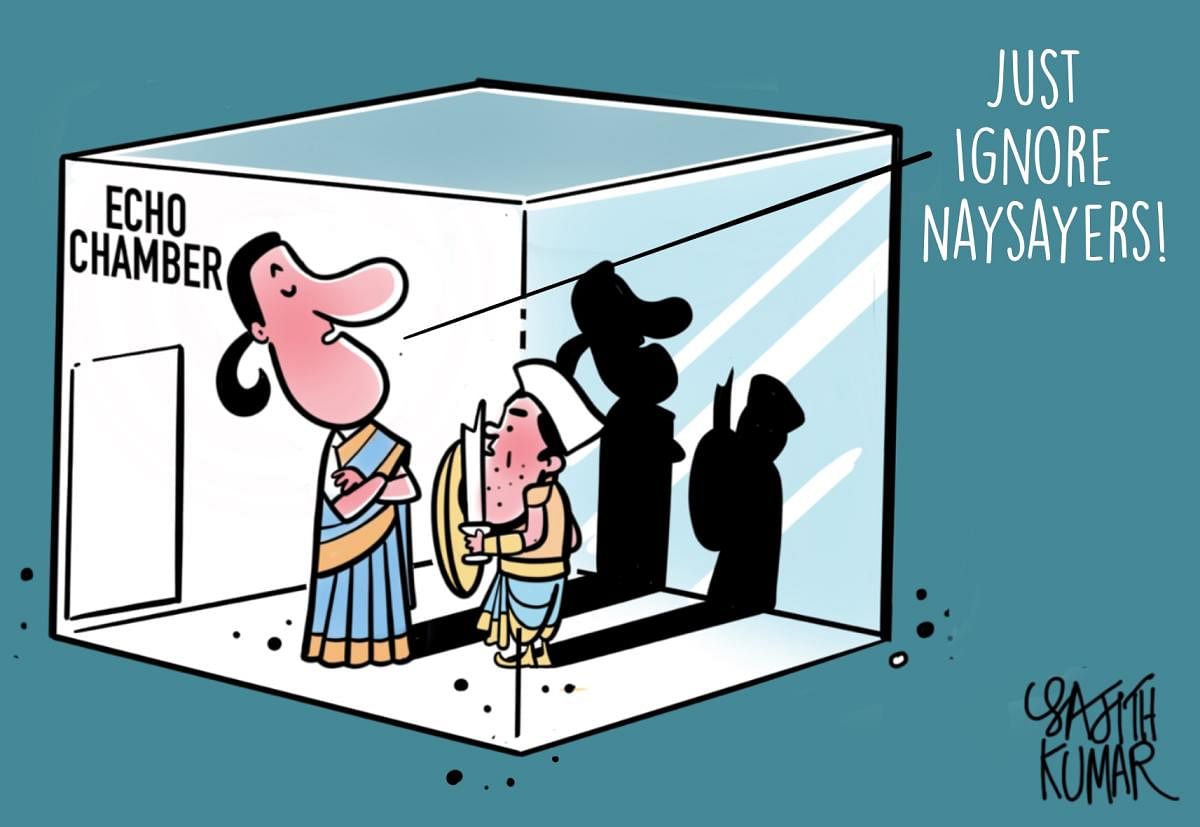

Nothing happens, nobody comes, nobody goes, it’s awful!” says Estragon in Samuel Beckett’s classic Waiting for Godot. And Vladimir adds, “We wait. We are bored. No, don’t protest, we are bored to death…A diversion comes along and what do we do? We let it go to waste.”
Even as the characters keep conversing in the play, nothing moves, and they just keep waiting for Godot.
That has become the story of the Congress party, too.
Battered by two consecutive Lok Sabha poll debacles and having lost most states it once ruled, Congress is in “steady decline” and runs the risk of being “marginalised” due to “erosion of support base” and its future is “presently at stake”, wrote 23 senior and prominent Congress leaders to party president Sonia Gandhi recently.
The nation was shocked that there were still some Congress leaders with the gumption after years of sycophancy, but the leadership was clearly not amused. The ‘rebels’ were berated, conspiracy theories were floated, they were told they were only helping BJP, the Congress durbar, aka Congress Working Committee, read out the riot act to them -- “no one will be or can be permitted to undermine or weaken the party and its leadership.” Sonia Gandhi was duly requested to continue as interim president, and she dutifully accepted the request.
Descent into confusion
When Rahul Gandhi resigned as party president following the 2019 Lok Sabha poll debacle, he went out slamming the party seniors for promoting their sons and daughters over the interests of the party, and hoping that all of them would own up their responsibility and quit just as he did. He also decreed that no one from his family would lead the party.
But as it panned out, the seniors stayed put, they brought Sonia Gandhi back to the helm, and marginalised Rahul Gandhi and his brigade.
In the months that followed, the party lost Madhya Pradesh, a state it had won in the 2018 Assembly election, as the cosmetic unity of the infamous fighting trio of Kamal Nath, Digvijay Singh and Jyotiraditya Scindia cracked, and the latter quit the party and joined the BJP in March this year. Just last month, Rajasthan, and the Congress’ other most prominent young leader Sachin Pilot, all but slipped away from the party’s hands due to the rivalry between Chief Minister Ashok Gehlot and Pilot.
While the 23 ‘rebels’ expressed concern about “leaders and functionaries leaving the party in a number of states” and the party “losing the confidence of the youth”, these losses started long ago and there is no sign that the party is going to be able to retain, let alone attract, young talent.
What Indira started
The ‘rebels’ expressed concern that Congress is no longer nurturing leaders at the state and national levels. But that started under Indira Gandhi when powerful regional leaders were side-lined as she attempted to “restructure the party from the top into an oligarchy,” as the fifth volume of the series ‘A Centenary History of the Indian National Congress’, brought out by a group of editors headed by Pranab Mukherjee in 2011 to commemorate 125 years of the organisation, noted.
“By the mid-1980s, considerable damage had occurred to the organisation and electoral base of the party from which it has not yet fully recovered. Her attempt to control the party led to absence of internal democracy leading to collapse of branches of the party in key states such as UP,” the book said.
Moreover, with the impression clear throughout the party that the top post will always be held by a Nehru-Gandhi and that no one else can take that position, no party leader has even attempted to rise beyond his or her regional identity. Sharad Pawar, who had national ambitions, was expelled from the party in 1999. Perhaps a Rajesh Pilot or a Madhavrao Scindia could have aspired to lead the party, but those possibilities ended with their tragic deaths in accidents in 2000 and 2001, respectively.
With the near decimation of Congress in state politics in UP, Bihar, Jharkhand, etc., there is now no pan-India leader in the party except the Nehru-Gandhis.
Here is where Congress is stuck. Its senior leaders are past their sell-by date; its young leaders have not shown the ability to deliver big.
Thus, Congress is left with this existential dilemma: For a long time, the Nehru-Gandhis could hold the party intact, and so the party needed them at the helm. But dynastic politics has gone out of fashion with the young Indian voter -- and half the country’s population is under 25 – and Congress cannot hope to win a national election under a dynast in 2024, unless the BJP undermines its own position totally under Modi-Shah. This realisation among younger Congress leaders has led to a situation in which the family’s ability to hold the party together has also come into question.
Secular Decline
Congress’ decline post-Rajiv Gandhi was visible in the 1991 election itself. Even the sympathy wave for the Nehru-Gandhis could not see the party through that year. Congress won only 244 seats, well short of simple majority.
By 2004, Congress was down to 145 (marginally better than the 114 it won in 1999) and it had to come to power in a coalition. In 2009, with Manmohan Singh, fresh from his ‘victory’ on the India-US nuclear deal issue, as its prime ministerial candidate, the party improved its tally to 206.
The phenomenal decline from 206 to just 44 seats in 2014 when Sonia was party chief and Rahul was taking key decisions was a shock to the party. That should have woken up the party to its leadership deficit, among other major issues. Instead, the A K Antony Committee report blamed the party’s poor communication and media outreach and the perception of it as tilting towards Muslims for its debacle.
Rahul Gandhi himself identified “organisational weakness” behind Congress’ failure to win elections in the states in 2012. Yet, till date, nothing much has been done to strengthen the organisation in the states.
Since 2014, even as it ascended all over the country, the BJP has effected a generational shift in its party power structure as well as in the Union cabinet and in many states.
Meanwhile, Congress keeps moving back and forth between Sonia and Rahul Gandhi at the top. In the states, after projecting young faces in MP, Rajasthan and Haryana, it reverted to the old guard to lead.
Rahul, the fall guy
While it is convenient to lay the blame for the party’s fall and inability to pick itself up in the states on Rahul Gandhi, history shows that Congress was never able to do so in any state where it lost to a regional party in the last four decades even when it was headed by Indira or Rajiv Gandhi – think Tamil Nadu (lost in 1967), Uttar Pradesh (1989), Bihar (1990). It took the party 15 years to wrest Madhya Pradesh and Chhattisgarh from BJP (2003-2018) when Sonia and Rahul were at the helm.
Perform or Perish
Congress’ decline started in the 1980s, aided by the rise of regional parties and heavyweights, and accelerated with the rise of the BJP. The system of loyal courtiers is still not letting democratic impulses to gain ground at the party’s top. Years before Rahul Gandhi became party president, it was he who said elections must be held for all bodies in the party, including the CWC. When the same idea came from the 23 party leaders recently, it was slammed as ‘rebellion’, even ‘conspiracy’.
It is ‘perform or perish’ time for Congress. It must embrace internal democracy, hold elections for all leadership roles from top to bottom, energise party cadres by making it possible for any of them to aspire to one day become party president, regain its ideological underpinnings and make it clear to the country. The writing on the wall is clear. Whether the party is able to read it and act in time remains to be seen. Can it even afford to wait six months to call the promised AICC session?
